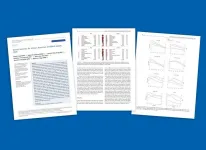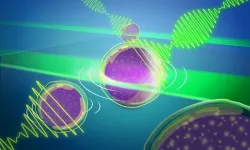(Press-News.org) A critically endangered species of shark could be forced to adapt to new habitats – or face extinction – as a result of changes in the ocean predicted to occur as a result of climate change, a new study has suggested.
The whitefin swellshark (Cephaloscyllium albipinnum) is a species of catshark found in deeper waters just off Australia’s south and east coasts. Its precise population numbers are uncertain, but the species has been assessed by the International Union for Conservation of Nature (IUCN) as Critically Endangered for a number of years due to declines largely attributed to fishing practices.
The new study, by researchers at the University of Plymouth, suggests that degrees of ocean change – including higher sea temperatures and shifts in ocean chemistry – predicted to occur by the end of this century could heighten its vulnerability.
Using a range of computer modelling, which accounted for the species’ favoured habitats and forecast ocean conditions, researchers found that up to 70% of currently suitable habitats will be lost over the next 75 years. There is predicted to be an area within the Great Australian Bight that could offer whitefin swellshark populations refuge, with favourable ocean conditions and sources of the food they need to survive.
The only challenges with that, based on current knowledge of the species’ whereabouts, are that the sharks – which grow to around 1.1-metres long – may need to move anywhere between 70km and 1100km in order to reach their potential new home. And it is likely they will not be the only species seeking refuge in the area, with a number of other marine species also likely to be forced to migrate polewards as they look to leave areas impacted by climate change.
Writing in the journal PeerJ, the researchers say the vulnerability of the species to the future effects of climate change is clear. However, they do believe there is cause for hope, with Australia being one of the world’s more proactive nations when it comes to implementing conservation measures and management strategies, such as marine protected areas (MPAs).
The study was carried out by Kerry Brown, a BSc (Hons) Marine Biology and Oceanography graduate from the University of Plymouth, as part of her undergraduate dissertation. She said: “Most people will probably have never seen them, but whitefin swellsharks are an incredibly pretty species. However, despite them being listed as critically endangered, we actually know very little about their behaviour given its habitats are deep in the ocean. What we do know is that they have been on our planet for a very long time, so will have had to adapt to changes in their environment before. However, the threat to their future survival now is very real unless we take urgent steps to protect them.”
Dr Robert Puschendorf, Associate Professor in Conservation Biology at the University of Plymouth, supervised the study and previously spent a decade working in Australia.
He added: “We have seen species move into different areas of the ocean in the past, so that offers some sense of hope for the whitefin swellshark. And the marine protected areas along the Australian coast are certainly a positive factor, although whether they are in the right place for this particular species is another matter. However, it does show the authorities in the region have the willingness and means to take action. The challenges faced by this – and other – species are now very different to what they may have encountered in the past, when you consider there are now very few parts of the planet that humans haven’t damaged in some way. But our study shows we are potentially in a position where we can do something about it.”
END
Scientists call for efforts to protect habitats of critically endangered shark species
2025-02-20
ELSE PRESS RELEASES FROM THIS DATE:
New ACS study shows cancer mortality rates among Black people declining, but remain higher than other racial and ethnic groups
2025-02-20
The American Cancer Society (ACS) today released Cancer Statistics for African American and Black People, 2025. According to the report, the cancer mortality rate declined from 1991 to 2022 by 49% and 33% in Black men and women, respectively, in the United States. However, African American and Black people continue to have a disproportionately elevated cancer burden compared to other population groups. According to the study, the risk of cancer death for Black individuals is two-fold that of White individuals for myeloma, prostate, uterine corpus (endometrial), and stomach cancers, and 40%-50% higher for colorectal, ...
Latest research finds people with certain heart conditions may play competitive sports
2025-02-20
Statement Highlights:
Although people with cardiovascular abnormalities have previously been considered ineligible for competitive sports participation, new evidence indicates that athletes of all ages who have certain heart abnormalities or diseases may often safely participate in competitive sports.
A new joint scientific statement from the American Heart Association and the American College of Cardiology emphasizes the need for shared decision-making between athletes and their clinicians, and provides guidance for health care professionals about how to assess risk when considering competitive sports participation for people with various cardiovascular conditions.
More ...
Biologists discover a new type of control over RNA splicing
2025-02-20
CAMBRIDGE, MA -- RNA splicing is a cellular process that is critical for gene expression. After genes are copied from DNA into messenger RNA, portions of the RNA that don’t code for proteins, called introns, are cut out and the coding portions are spliced back together.
This process is controlled by a large protein-RNA complex called the spliceosome. MIT biologists have now discovered a new layer of regulation that helps to determine which sites on the messenger RNA molecule the spliceosome will target.
The research team discovered ...
Surprising finding for acid reducing drugs
2025-02-20
Acid reducing medicines from the group of proton pump inhibitors (PPIs) are best-selling drugs that prevent and alleviate stomach problems. PPIs are activated in the acid-producing cells of the stomach, where they block acid production. Researchers at the German Cancer Research Center (DKFZ) made the surprising discovery that zinc-carrying proteins, which are found in all cells, can also activate PPIs – without the presence of gastric acid. The result could be a key to understanding the side effects of PPIs.
Excessive gastric acid can cause not only heartburn, but also chronic complaints such as gastritis or even a stomach ...
Pushing the limits of ‘custom-made’ microscopy
2025-02-20
A new paper updates an EMBL technology advance even further. More details about the original technology can be found in our initial reporting here.
EMBL tech developers have made an important leap forward with a novel methodology that adds an important microscopy capability to life scientists’ toolbox. The advance represents a 1,000-fold improvement in speed and throughput in Brillouin microscopy and provides a way to view light-sensitive organisms more efficiently.
“We were on a quest to speed up image acquisition,” said Carlo Bevilacqua, lead author on ...
Deep Nanometry reveals hidden nanoparticles
2025-02-20
Researchers including those from the University of Tokyo developed Deep Nanometry, an analytical technique combining advanced optical equipment with a noise removal algorithm based on unsupervised deep learning. Deep Nanometry can analyze nanoparticles in medical samples at high speed, making it possible to accurately detect even trace amounts of rare particles. This has proven its potential for detecting extracellular vesicles indicating early signs of colon cancer, and it is hoped that it can be applied to other medical and industrial fields.
Did you know your ...
Screen time linked to bipolar and manic symptoms in U.S. preteens
2025-02-20
Toronto, ON - Preteens who spend more time on screens are more likely to develop manic symptoms years two-years later, according to a new study published in Social Psychiatry and Psychiatric Epidemiology.
The findings reveal that 10- to 11-year-olds who engage heavily with social media, video games, texting, and videos show a greater risk of symptoms such as inflated self-esteem, decreased need for sleep, distractibility, rapid speech, racing thoughts, and impulsivity — behaviors characteristic of manic episodes, a key feature of bipolar-spectrum disorders.
“Adolescence is a particularly ...
In ancient stellar nurseries, some stars are born of fluffy clouds
2025-02-20
Fukuoka, Japan—How are stars born, and has it always been this way?
Stars form in regions of space known as stellar nurseries, where high concentrations of gas and dust coalesce to form a baby star. Also called molecular clouds, these regions of space can be massive, spanning hundreds of light-years and forming thousands of stars. And while we know much about the life cycle of a star thanks to advances in technology and observational tools, precise details remain obscure. For example, did stars form this way in the early universe?
Publishing in The Astrophysical Journal, researchers from Kyushu University, in collaboration with Osaka Metropolitan ...
Blood pressure drug could be a safer alternative for treating ADHD symptoms, finds study
2025-02-20
Blood pressure drug could be a safer alternative for treating ADHD symptoms, finds study
Repurposing amlodipine, a commonly used blood pressure medicine, could help manage attention-deficit/ hyperactivity disorder (ADHD) symptoms, according to an international study involving the University of Surrey.
In a study published in Neuropsychopharmacology, researchers tested five potential drugs in rats bred to exhibit ADHD-like symptoms. Among them, only amlodipine, a common blood pressure medication, significantly reduced hyperactivity.
To ...
Daily cannabis use linked to public health burden
2025-02-20
WASHINGTON (Feb. 20, 2025)--A new study analyzes the disease burden and the risk factors for severity among people who suffer from a condition called cannabinoid hyperemesis syndrome. Researchers at the George Washington University say the condition occurs in people who are long-term regular consumers of cannabis and causes nausea, uncontrollable vomiting and excruciating pain in a cyclical pattern that often leads to repeated trips to the hospital.
“This is one of the first large studies to examine the burden of disease associated with this cannabis-linked syndrome,” says Andrew Meltzer, professor of emergency medicine ...


